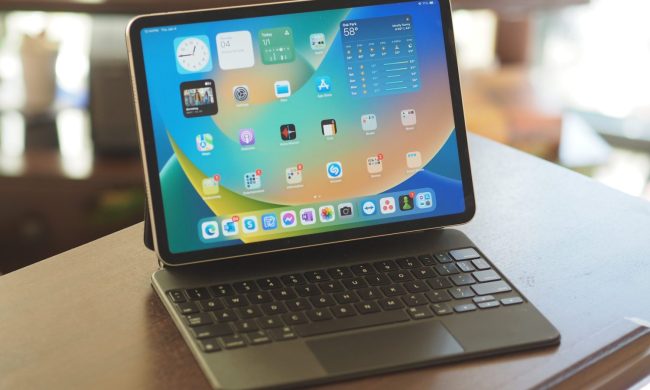Apple has long resisted the idea of calling the iPad a true “2-in-1” that can be both a laptop and a tablet. That’s Microsoft’s language. That’s the Surface Pro.
Ever stubborn, Apple still doesn’t categorize its new iPad Pro as a “2-in-1.” Still, the inclusion of a full keyboard, touchpad, and cursor support argues otherwise. It’s a 2-in-1 in everything but name.
This is the formula Microsoft invented. And it’s about to be perfected by the iPad Pro.
Work or play?

The 2-in-1 was pitched as a no-compromise device. A tablet for play, a proper laptop for work. The two primary options today, the iPad Pro and Surface Pro, have always leaned heavily in one direction or the other.
The iPad Pro has a wealth of full-screen tablet apps and games made for touch control only. The operating system uses a series of touch gestures to help you navigate, and the buttons are large, just begging to be tapped.
The second you try to get real work done, though, you run into issues. Early iPads didn’t even offer multitasking, and mouse support was MIA for years.
Using the Surface Pro without its keyboard is a disaster waiting to happen.
The Surface Pro has the opposite problem. As a full Windows 10 device, it can run every application you’re used to — whether that’s Excel or Photoshop. It has a file system, a USB port, a touchpad, the whole shebang.
Try and disconnect the Type Cover keyboard for tablet usage, though, and you’re set adrift. The Surface Pro is still sold without its iconic Type Keyboard Cover under the pretense that it can be used as a tablet on its own. That’s a disaster waiting to happen.
Despite its success, Windows 10 still isn’t well optimized for touch control. The “tablet mode” that exists is a holdover from Windows 8, lacking touch gestures and large buttons.
In the past, you had to make a choice. If you cared more about entertainment and personal use, the iPad was attractive. If you needed a serious work machine, though, the Surface Pro usually won out.
The new iPad Pro changes that.
Apple does the unthinkable
Apple has improved multitasking on an iPad, offering split-screen modes and desktop widgets. An improved typing experience, which includes a more traditional keyboard layout and more travel, go a long way.
The biggest hurdle when using the iPad Pro has always been text selection. Without a cursor, it’s a pain. Reaching up to the screen is annoying, as is the iOS-style text selection. It’s extremely clumsy if you work in Word or Excel.
For its newest iPad Pro, Apple took a serious step toward making it a proper laptop replacement. It has touchpad support and, more specifically, a cursor.
The iPad Pro’s new cursor isn’t your standard pointer. It’s a bit more contextual than a desktop cursor. The standard look is a small circle, to match the touch-centric nature of the iPad. When navigating apps, it’ll lock you onto buttons and usable fields. It even supports gestures.
Who knows how this addition will change the apps we know and love once developers begin to orient their apps around this new input. Apple says support for the cursor and touchpads will automatically work with all apps, but developers will have access to the API to further build out the experience.
Text selection really is the kicker. Whether it’s copy and paste, or selecting cells in Excel, the ability to be productive on an iPad Pro just skyrocketed.
Microsoft will need to do better
The many improvements found in the new iPad Pro, and recent versions of iPadOS, close the gap between the iPad and the Surface Pro. Microsoft’s offering is still a more familiar experience for many professionals, but the iPad Pro is now a truly viable alternative.
Unfortunately, Microsoft hasn’t had the same luck in fixing the Surface Pro’s deficiencies. Despite eight iterations, little has been done to improve the tablet experience of the Surface Pro. The tablet mode hasn’t been updated since the launch of Windows 10, and the app situation is as hopeless as ever.
The Surface Pro also lacks the performance it needs for gaming. Its weak graphics solution can’t handle modern 3D titles, while Apple’s iPad Pro has an excellent mobile GPU, an app store full of games, and a subscription gaming service, Apple Arcade.
Microsoft’s attempts to create a unified modern app ecosystem never panned out, leaving its app store vacant. The limp launch of the Surface Pro X is a prime example of this.

Microsoft does have a possible solution in the Surface Neo, a dual-screen device that runs a new operating system called Windows 10X. It’s a 2-in-1 device in its own right, and Windows 10X is pursuing a touch-friendly design.
However, Microsoft gave up on its efforts to push developers toward making tablet-friendly apps, so Surface devices will always struggle in that department. The Windows app store is way behind the curve. As a result, it’s missing all sorts of tablet-friendly apps you’ll easily find on Apple’s App Store.
The Surface Pro is still a better laptop replacement than the iPad Pro. However, as a 2-in-1, the iPad Pro has become the true no-compromise device.


